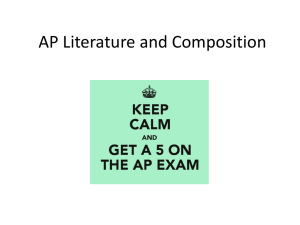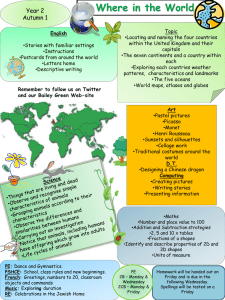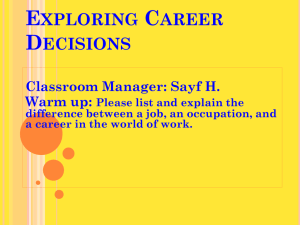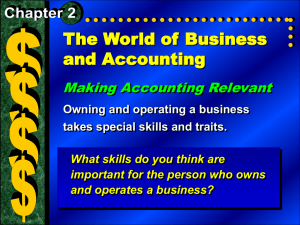So how are you going? Exploring evaluation and monitoring
advertisement
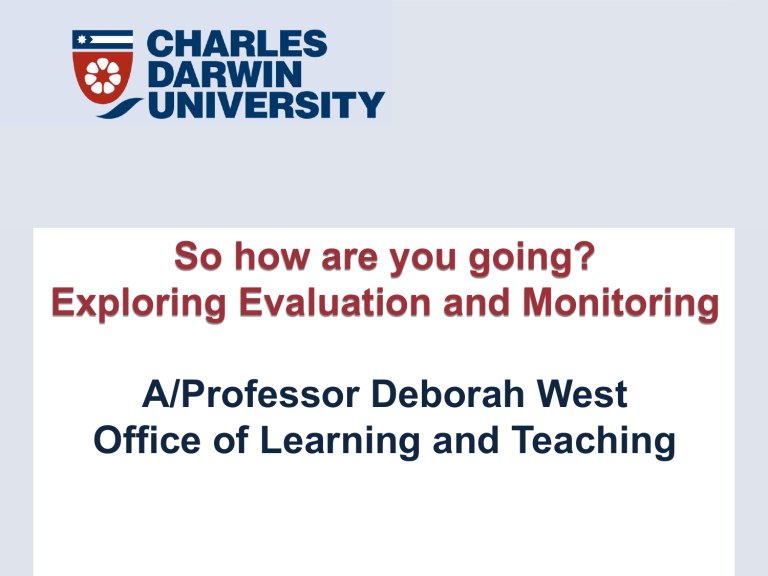
So how are you going? Exploring Evaluation and Monitoring A/Professor Deborah West Office of Learning and Teaching WHY? • Continual improvement for student outcomes • To become better teachers • Help us to understand if we are doing the right things to improve retention • Can also link to teaching and learning citations, awards, promotion process What is SoTL? The scholarship of learning and teaching refers to a systematic approach to reflecting on teaching practice to improve outcomes for students. It has a number of key features: • Focus on improving student learning • Systematic approach • Focus on action/impact – doing something with the knowledge (not just research for research sake) • Dissemination/sharing/peer review Exploring Evaluation and Monitoring| 1 May 2015| Slide 3 Key steps in SoTL 1. Using a theory, model or framework to ground the initiative and provide the justification of action 2. Identifying an intervention 3. Formulating an investigative question 4. Conducting an investigation 5. Produce a result in the form of a public artefact 6. Inviting peer review/dissemination Exploring Evaluation and Monitoring| 1 May 2015| Slide 4 Activity • Brainstorm on your table (and write them down on the paper provided) the sources of data/evidence that you might be able to use to reflect on your unit, the curriculum and teaching and learning more broadly (any aspect) Exploring Evaluation and Monitoring| 1 May 2015| Slide 5 How? • Learnline tools – Unit reports – Performance dashboard – Survey tool – Statistics tracking – Item analysis on tests • My View • Grade Reports • Student Focus groups • Peer review • Moderation • Benchmarking/Calibration Exploring Evaluation and Monitoring| 1 May 2015| Slide 6 Sally Kift’s Transition Pedagogy http://transitionpedagogy.com/ Exploring Evaluation and Monitoring| 1 May 2015| Slide 7 Transition http://transitionpedagogy.com The first year curriculum explicitly assists transition academically and socially into learning in higher education and the new discipline. • Good first year curriculum design aids transition from a student’s previous educational experience to the nature of learning in higher education and their new discipline as part of their life long learning journey. Exploring Evaluation and Monitoring| 1 May 2015| Slide 8 Diversity http://transitionpedagogy.com The first year curriculum embraces and supports the diversity and reality of students’ backgrounds, previous experiences and preparedness for university. • Good first year curriculum design acknowledges student diversity because diversity may exacerbate transition issues and, in the current massified sector, few assumptions can be made about students’ entering knowledge, skills and attitudes. Diversity in this context is very broad and includes, for example, membership of atrisk or equity groups, non-traditional cohorts, and students’ various patterns and timing of engagement with the first year curriculum (e.g., mid-year entry). Exploring Evaluation and Monitoring| 1 May 2015| Slide 9 Design http://transitionpedagogy.com The first year curriculum is designed intentionally for commencing students, based on evidence from practice and research. • Good first year curriculum design is student-focused, explicit and relevant and provides the foundation and scaffolding for learning success. The first year curriculum objectives should be articulated and, desirably, the first year curriculum should form a coherent, integrated whole. Exploring Evaluation and Monitoring| 1 May 2015| Slide 10 Engagement http://transitionpedagogy.com The first year curriculum incorporates pedagogies, teaching approaches and materials that engage students in their learning and facilitates interactions with peers and staff. Good first year curriculum design enacts an engaging and involving pedagogy. AUSSE (ACER, 2008) now provides us with very clear guidance around the “activities and conditions likely to generate high quality learning” (ACER, 2008, vi) and evidences that “all aspects of engagement have a strong positive relationship with a range of general, specific, social, personal, ethical and interpersonal capabilities” (ACER, 2008, ix). Pascarella & Terenzini (2005, 646) record that – With striking consistency, studies show that innovative, active, collaborative, and constructivist instructional approaches shape learning more powerfully, in some forms by substantial margins, than do conventional lecture-discussion and text-based approaches. Exploring Evaluation and Monitoring| 1 May 2015| Slide 11 Assessment http://transitionpedagogy.com The first year curriculum aids transition to higher education assessment and provides early feedback. • Good first year curriculum design aids students’ transition to higher education assessment, introduces a range of appropriate assessment practices and provides early feedback on student progress to students and staff. Assessment increases in complexity from first to later years. Exploring Evaluation and Monitoring| 1 May 2015| Slide 12 Evaluation and Monitoring http://transitionpedagogy.com The first year curriculum should itself be evaluated and should monitor for student engagement. • Good first year curriculum design is itself evidence-based and evaluated, and desirably includes mechanisms to monitor for student engagement and performance, the latter allowing then for timely intervention in aid of students who are at risk of not being successful. Exploring Evaluation and Monitoring| 1 May 2015| Slide 13 Activity Where do our data sources fit with Sally’s model? On the handout put in the various sources of data that might help you with the key elements. Exploring Evaluation and Monitoring| 1 May 2015| Slide 14 Activity: Asking the right questions Individually think about some questions that you could add to the My View survey in two groups: • That fit with the model in various domains • Other questions that you would like to ask student to help you improve your unit and/or your teaching. Write your questions on yellow sticky notes Discuss your questions with others on the table considering question structure, appropriateness etc. Exploring Evaluation and Monitoring| 1 May 2015| Slide 15 What Next? • • • • Think about it Prepare Plan Think about the approach and the questions • Be consistent Exploring Evaluation and Monitoring| 1 May 2015| Slide 16



